New IAN Personnel
 In Spring 2005, UMCES hired Troy Keller to be a Water Quality Analyst, a position located at the Chesapeake Bay Program Office in Annapolis, MD. In this position, he will provide technical statistical and other analytical capabilities to the Nontidal Water Quality Workgroup. Troy came to us from the St. John's River Water Management District, where he served as an Environmental Scientist. Troy's degrees include a BA in Zoology from Ohio Wesleyan University, an MS in Biology from the University of Michigan, and a doctorate in Biology from the University of Michigan. Troy's interests outside of work include: kayaking, bicycling, hiking, running, and playing ultimate frisbee and soccer. Please join us in welcoming Troy to UMCES.
In Spring 2005, UMCES hired Troy Keller to be a Water Quality Analyst, a position located at the Chesapeake Bay Program Office in Annapolis, MD. In this position, he will provide technical statistical and other analytical capabilities to the Nontidal Water Quality Workgroup. Troy came to us from the St. John's River Water Management District, where he served as an Environmental Scientist. Troy's degrees include a BA in Zoology from Ohio Wesleyan University, an MS in Biology from the University of Michigan, and a doctorate in Biology from the University of Michigan. Troy's interests outside of work include: kayaking, bicycling, hiking, running, and playing ultimate frisbee and soccer. Please join us in welcoming Troy to UMCES.
New UMCES/CBPO Water Quality Analyst
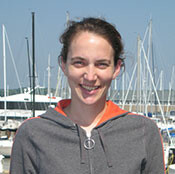 UMCES recently hired Jeni Keisman to be a Water Quality Analyst at the Chesapeake Bay Program office in Annapolis, MD. She will be providing analytical support to the Tidal Monitoring and Analysis Workgroup. Jeni has a M.S. in sustainable development & conservation biology from the University of Maryland, and a BA in History from Saint Mary’s College of Maryland. She is currently a PhD candidate in Ecology and Evolutionary Biology at Princeton University, where her dissertation research examines the effects of different leaf litters on soil microbial communities and nutrient cycling. Jeni spends most of her time outside of work running after her 1-yr-old son Parker and working on her thesis. She looks forward in the near future to resuming hobbies such as relaxing with her husband Vince, sailing, camping, and reading trashy fiction.
UMCES recently hired Jeni Keisman to be a Water Quality Analyst at the Chesapeake Bay Program office in Annapolis, MD. She will be providing analytical support to the Tidal Monitoring and Analysis Workgroup. Jeni has a M.S. in sustainable development & conservation biology from the University of Maryland, and a BA in History from Saint Mary’s College of Maryland. She is currently a PhD candidate in Ecology and Evolutionary Biology at Princeton University, where her dissertation research examines the effects of different leaf litters on soil microbial communities and nutrient cycling. Jeni spends most of her time outside of work running after her 1-yr-old son Parker and working on her thesis. She looks forward in the near future to resuming hobbies such as relaxing with her husband Vince, sailing, camping, and reading trashy fiction.
IAN personnel changes
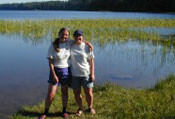 Recently, Michael Williams moved from his role as a Water Quality Analyst at the Chesapeake Bay Program Office to become our new science integrator based at the Annapolis Synthesis Center where he joins Jane Thomas. Our summer intern for 2007, Emily Nauman, recently accepted a position as the new science communicator with EcoCheck. Holly Davis comes to UMCES and the Chesapeake Bay Program from the west coast where she has worked most recently for The Nature Conservancy in San Francisco, California. She will be working as a GIS Analyst making maps, maintaining the CBPO's GIS database, and assisting with web site redesign and science communication efforts. Holly's background includes a BS in Geology and Oceanography from Stanford University, an MS in Engineering from the University of Colorado, Boulder, a Science Writing Certificate from the University of California, Santa Cruz and a GIS Certificate from the University of California, Riverside. Her time outside of work is spent enjoying water sports, making handmade soaps or collecting clean jokes.
Recently, Michael Williams moved from his role as a Water Quality Analyst at the Chesapeake Bay Program Office to become our new science integrator based at the Annapolis Synthesis Center where he joins Jane Thomas. Our summer intern for 2007, Emily Nauman, recently accepted a position as the new science communicator with EcoCheck. Holly Davis comes to UMCES and the Chesapeake Bay Program from the west coast where she has worked most recently for The Nature Conservancy in San Francisco, California. She will be working as a GIS Analyst making maps, maintaining the CBPO's GIS database, and assisting with web site redesign and science communication efforts. Holly's background includes a BS in Geology and Oceanography from Stanford University, an MS in Engineering from the University of Colorado, Boulder, a Science Writing Certificate from the University of California, Santa Cruz and a GIS Certificate from the University of California, Riverside. Her time outside of work is spent enjoying water sports, making handmade soaps or collecting clean jokes.
New IAN personnel
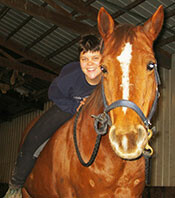 Katie Foreman joined UMCES and the Chesapeake Bay Program as the new non-tidal water quality analyst. She is an Iowa native, where she received her undergraduate and graduate degrees in geography from the University of Iowa. Over the past 6 years, Katie has spent many hours in Iowa's lakes, streams, and rivers working as a researcher for the Iowa Department of Natural Resources. She worked in several programs within the Department including: Beach Monitoring, Volunteer Water Quality Monitoring, Watershed Improvement, and Watershed Monitoring and Assessment. In her free time she looks forward to riding her horse, practicing yoga, and learning how to sail.
Katie Foreman joined UMCES and the Chesapeake Bay Program as the new non-tidal water quality analyst. She is an Iowa native, where she received her undergraduate and graduate degrees in geography from the University of Iowa. Over the past 6 years, Katie has spent many hours in Iowa's lakes, streams, and rivers working as a researcher for the Iowa Department of Natural Resources. She worked in several programs within the Department including: Beach Monitoring, Volunteer Water Quality Monitoring, Watershed Improvement, and Watershed Monitoring and Assessment. In her free time she looks forward to riding her horse, practicing yoga, and learning how to sail.
Jeni Keisman, PhD
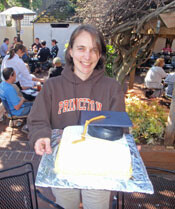 Jeni Keisman successfully defended her PhD dissertation at the Department of Ecology and Evolutionary Biology, Princeton University on April 10. Jeni's thesis was titled "Species effects on nutrient cycling in forests: A study of leaf litter's role in shaping soil microbial communities and nutrient recycling". In her current position as a Water Quality Analyst at the Chesapeake Bay Program, Jeni worked part-time to finish her dissertation with her thesis advisor Dr. Lars Hedin from Princeton, with access to Jess Parker and Pat Megonigal's labs at the Smithsonian Environmental Research Center. Jeni has now begun working at the Chesapeake Bay Program full-time and looks forward to simplifying her life.
Jeni Keisman successfully defended her PhD dissertation at the Department of Ecology and Evolutionary Biology, Princeton University on April 10. Jeni's thesis was titled "Species effects on nutrient cycling in forests: A study of leaf litter's role in shaping soil microbial communities and nutrient recycling". In her current position as a Water Quality Analyst at the Chesapeake Bay Program, Jeni worked part-time to finish her dissertation with her thesis advisor Dr. Lars Hedin from Princeton, with access to Jess Parker and Pat Megonigal's labs at the Smithsonian Environmental Research Center. Jeni has now begun working at the Chesapeake Bay Program full-time and looks forward to simplifying her life.
Research findings for key bay fisheries species
 Fisheries research funded by the NOAA Chesapeake Bay Office (NCBO) provides science and information to enable natural resource managers to make informed decisions. The NCBO Fisheries Science Symposium is a chance for fisheries scientists in the Bay area to present their research findings and create collaborations. This newsletter is an EcoCheck/NCBO collaboration and summarizes some of the key topics presented at the 2009 symposium.
Fisheries research funded by the NOAA Chesapeake Bay Office (NCBO) provides science and information to enable natural resource managers to make informed decisions. The NCBO Fisheries Science Symposium is a chance for fisheries scientists in the Bay area to present their research findings and create collaborations. This newsletter is an EcoCheck/NCBO collaboration and summarizes some of the key topics presented at the 2009 symposium.
New Chesapeake Bay Program Office Database Manager
 Sucharith Ravi joined the UMCES team last week as a Database Manager for Chesapeake Bay Program Office in Annapolis. He worked as a Database Developer in New Jersey where he gained his experience in relational database management systems and web designing. His educational background includes a Master's in Electrical and Computer Engineering from University Of Missouri, and a Bachelors of Technology in Electrical and Communications Engineering from JNTU, India. He just moved to Annapolis a week ago and is looking to find some nice places to network and ready to make some new friends.
Sucharith Ravi joined the UMCES team last week as a Database Manager for Chesapeake Bay Program Office in Annapolis. He worked as a Database Developer in New Jersey where he gained his experience in relational database management systems and web designing. His educational background includes a Master's in Electrical and Computer Engineering from University Of Missouri, and a Bachelors of Technology in Electrical and Communications Engineering from JNTU, India. He just moved to Annapolis a week ago and is looking to find some nice places to network and ready to make some new friends.
New Chesapeake Bay Program Office Data and Modeling Specialist
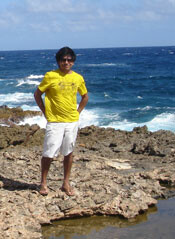 Guido Yactayo has joined UMCES-CBPO as the new Data and Modeling Specialist. Guido comes with five years of experience garnered while working in the International Potato Center in South America. The project's goals were to reduce poverty and to improve natural resource management in Andean regions. Guido has his bachelor's degree in environmental engineering and a masters in biological systems engineering at Virginia Tech, focusing on nutrient transport modeling in Virginia karst regions. In his spare time, he enjoys mountain biking and watching independent films and documentaries. He is keen to try snowboarding again this coming winter.
Guido Yactayo has joined UMCES-CBPO as the new Data and Modeling Specialist. Guido comes with five years of experience garnered while working in the International Potato Center in South America. The project's goals were to reduce poverty and to improve natural resource management in Andean regions. Guido has his bachelor's degree in environmental engineering and a masters in biological systems engineering at Virginia Tech, focusing on nutrient transport modeling in Virginia karst regions. In his spare time, he enjoys mountain biking and watching independent films and documentaries. He is keen to try snowboarding again this coming winter.
STAR team formed at Chesapeake Bay Program
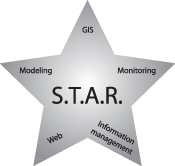 A new Science & Technical Analysis & Reporting (STAR) team has been formed to facilitate the scientific support at the Chesapeake Bay Program. The STAR team includes monitoring, modeling, geographic information science, web, and information management scientists and will be initially chaired by Bill Dennison. University of Maryland Center for Environmental Science staff at the Chesapeake Bay Program (Katie Foreman, Jeni Keisman, Sucharith Ravi, Guy Stephens, Ping Wang, Howard Weinberg, Jing Wu, and Guido Yactayo) will participate in the STAR activities to support the Goal Implementation Teams. The Goal Teams have been charged with delivery of the Chesapeake Bay Program targets and milestones. ChesapeakeStat is a data delivery system being created to provide resource managers accurate and timely information for decision-making, and the STAR team will populate the data layers, conduct analyses, and interpret data for ChesapeakeStat.
A new Science & Technical Analysis & Reporting (STAR) team has been formed to facilitate the scientific support at the Chesapeake Bay Program. The STAR team includes monitoring, modeling, geographic information science, web, and information management scientists and will be initially chaired by Bill Dennison. University of Maryland Center for Environmental Science staff at the Chesapeake Bay Program (Katie Foreman, Jeni Keisman, Sucharith Ravi, Guy Stephens, Ping Wang, Howard Weinberg, Jing Wu, and Guido Yactayo) will participate in the STAR activities to support the Goal Implementation Teams. The Goal Teams have been charged with delivery of the Chesapeake Bay Program targets and milestones. ChesapeakeStat is a data delivery system being created to provide resource managers accurate and timely information for decision-making, and the STAR team will populate the data layers, conduct analyses, and interpret data for ChesapeakeStat.
Job Vacancy: Estuarine Response Data Analyst
The goal of the position is to provide analysis support for the diagnosis of the natural conditions and anthropogenic-based reasons behind the observed current status and long-term trends in tidal Chesapeake Bay basin water quality conditions. The position will be responsible for assessing the effectiveness of management actions based on long-term observed responses within the estuarine and the surrounding watershed ecosystems. The position will involve providing leadership by organizing and coordinating teams drawn from the larger regional scientific and management community. These teams will be charged with the responsibility of synthesizing data, analyzing results, and developing information for effective communication products focused on resolving the scientific and technical aspects of a select set of issues relevant to the management on an annual basis.Welcome to Richard Tian
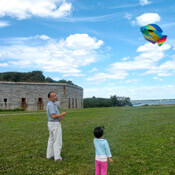 Dr. Richard Tian has joined IAN through our partnership with the Chesapeake Bay Program. He is engaged in our modeling effort related to restoration of the Chesapeake Bay. Richard moved with his wife and daughter from Massachusetts, where he worked with the University of Massachusetts and Harvard University. He has experience in coupled physico-biological and water quality model development and application. He was the lead scientist in developing the generalized biological model (GBM) coupled with both Harvard Ocean Prediction System (HOPS) and Finite-Volume Coastal Ocean Model (FVCOM). He looks forward to working with the IAN group and striving toward best management practice and restoration.
Dr. Richard Tian has joined IAN through our partnership with the Chesapeake Bay Program. He is engaged in our modeling effort related to restoration of the Chesapeake Bay. Richard moved with his wife and daughter from Massachusetts, where he worked with the University of Massachusetts and Harvard University. He has experience in coupled physico-biological and water quality model development and application. He was the lead scientist in developing the generalized biological model (GBM) coupled with both Harvard Ocean Prediction System (HOPS) and Finite-Volume Coastal Ocean Model (FVCOM). He looks forward to working with the IAN group and striving toward best management practice and restoration.
Farewell to Katie Foreman and welcome to Christina Lyerly
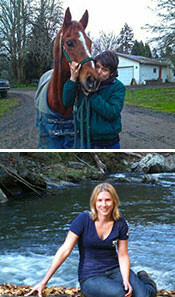 Katie Foreman worked for UMCES at the Chesapeake Bay Program for five years as the Non-tidal Water Quality Analyst. She developed the Chesapeake Watershed Stream Health Index which is an overall assessment of benthic health. In addition, she coordinated the non-tidal workgroup, worked on many reports, including the annual Bay Barometer, and participated in many workshops and conferences. We are sad to see Katie leave, but she has a wonderful new opportunity with the Oregon Department of Environmental Quality. We wish Katie all the best! Christina Lyerly joins UMCES to jointly support IAN and the Chesapeake Bay Program office. She will assist in co-authoring a Lessons Learned brochure, detailing the results of best management practices implemented in the Chesapeake Bay watershed. Christina recently completed an MPP—Environmental Policy and an MS—Sustainable Development and Conservation Biology at the University of Maryland. She gained experience with Chesapeake Bay water quality issues while working at the World Resources Institute and participating in the DNR's Stream Waders program. Sailing with her family inspired her love of the Bay, and she is excited to help improve its health. In addition to sailing, you will also find her skiing the slopes, hiking, and kayaking in western MD and WV.
Katie Foreman worked for UMCES at the Chesapeake Bay Program for five years as the Non-tidal Water Quality Analyst. She developed the Chesapeake Watershed Stream Health Index which is an overall assessment of benthic health. In addition, she coordinated the non-tidal workgroup, worked on many reports, including the annual Bay Barometer, and participated in many workshops and conferences. We are sad to see Katie leave, but she has a wonderful new opportunity with the Oregon Department of Environmental Quality. We wish Katie all the best! Christina Lyerly joins UMCES to jointly support IAN and the Chesapeake Bay Program office. She will assist in co-authoring a Lessons Learned brochure, detailing the results of best management practices implemented in the Chesapeake Bay watershed. Christina recently completed an MPP—Environmental Policy and an MS—Sustainable Development and Conservation Biology at the University of Maryland. She gained experience with Chesapeake Bay water quality issues while working at the World Resources Institute and participating in the DNR's Stream Waders program. Sailing with her family inspired her love of the Bay, and she is excited to help improve its health. In addition to sailing, you will also find her skiing the slopes, hiking, and kayaking in western MD and WV.
2012 Chesapeake Bay report card
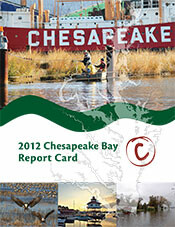 This report card provides a transparent, timely, and geographically detailed assessment of Chesapeake Bay. In 2012, the methods for the report card have changed to include five water quality indicators and two biotic indicators. In 2012, the overall grade for Chesapeake Bay is a 47%, a C. This means the Bay is in moderate health. Fisheries indicators as well as trajectories of reporting region health are also presented. For further details, visit the Report Card website.
This report card provides a transparent, timely, and geographically detailed assessment of Chesapeake Bay. In 2012, the methods for the report card have changed to include five water quality indicators and two biotic indicators. In 2012, the overall grade for Chesapeake Bay is a 47%, a C. This means the Bay is in moderate health. Fisheries indicators as well as trajectories of reporting region health are also presented. For further details, visit the Report Card website.
Chesapeake Bay dissolved oxygen forecast for summer 2013
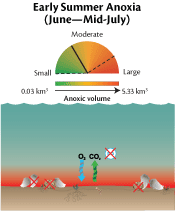 For the past several years, Chesapeake Bay scientists have collaborated with the Integration and Application Network to forecast Chesapeake Bay summer dissolved oxygen conditions, based on flow and nutrient loading conditions through May. Ecological forecasts provide resource managers with information that can be used to guide restoration, enable proactive communication of Bay conditions, and help direct research activities. The average summer (June to September) hypoxia forecast predicts better than average conditions for 2013. This forecast is based on Susquehanna River flow (January to May) and wind direction and speed across the Bay.
For the past several years, Chesapeake Bay scientists have collaborated with the Integration and Application Network to forecast Chesapeake Bay summer dissolved oxygen conditions, based on flow and nutrient loading conditions through May. Ecological forecasts provide resource managers with information that can be used to guide restoration, enable proactive communication of Bay conditions, and help direct research activities. The average summer (June to September) hypoxia forecast predicts better than average conditions for 2013. This forecast is based on Susquehanna River flow (January to May) and wind direction and speed across the Bay.
Four new job vacancies announced
The University of Maryland Center for Environmental Science is currently advertising for the following four positions.- Estuarine and Watershed Response Data Analyst
- Maryland-Delaware Climate Change Education, Assessment and Research project manager
- Web Designer
- Web Developer
Cloud Solutions Specialist for the Chesapeake Collaborative Computer Center
The University of Maryland Center for Environmental Science invites applications for a Cloud Solutions Specialist. This position is a great opportunity to use your skills and experience to contribute to a variety of highly visible projects while learning about the latest technologies and best practices. The successful candidate will work in partnership with the U.S. EPA Chesapeake Bay Program staff at its Annapolis office.IAN welcomes Zach Friedman
 Zach is a designer who is passionate about the details. He loves to innovate and craft beautifully simple designs. A graduate from The Art Institute of Washington with a Bachelor of Fine Arts degree in Graphic Design, he combines elements of traditional print design with a love of typography to create interactive and engaging online experiences. Zach is joining the IAN/CBP team as a web designer, responsible for the user interaction and user experience of the Chesapeake Bay Program website, web applications, and mobile products. Previously, Zach worked as a designer on the United States Army web team. Born and raised in Maryland, Zach loves to travel. When not at work, he might be outside gardening, playing board games, and/or spending time with his family. He loves coffee, making people laugh, and enjoying the occasional nap (just not at work, of course).
Zach is a designer who is passionate about the details. He loves to innovate and craft beautifully simple designs. A graduate from The Art Institute of Washington with a Bachelor of Fine Arts degree in Graphic Design, he combines elements of traditional print design with a love of typography to create interactive and engaging online experiences. Zach is joining the IAN/CBP team as a web designer, responsible for the user interaction and user experience of the Chesapeake Bay Program website, web applications, and mobile products. Previously, Zach worked as a designer on the United States Army web team. Born and raised in Maryland, Zach loves to travel. When not at work, he might be outside gardening, playing board games, and/or spending time with his family. He loves coffee, making people laugh, and enjoying the occasional nap (just not at work, of course).
IAN welcomes Rebecca Murphy
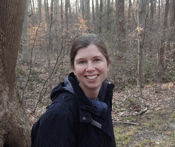 Rebecca Murphy joins IAN working at the Chesapeake Bay Program Office examining trends in water quality data. Rebecca earned her PhD from Johns Hopkins where her research involved implementing spatial interpolation to analyze long-term trends in hypoxia and stratification in Chesapeake Bay. She studied at Cornell University for her undergraduate and masters degrees. She has worked in the environmental consulting field in sediment remediation and water quality studies using statistics, GIS, and dynamic modeling tools. Rebecca enjoys identifying and linking the right mix of analysis tools, models, and data to examine environmental problems and is eager to apply these skills to identifying trends and changes in the health of the Chesapeake Bay. Originally from North Carolina, she has lived in Maryland for seven years and loves being so close to the water and learning more about the Bay every day.
Rebecca Murphy joins IAN working at the Chesapeake Bay Program Office examining trends in water quality data. Rebecca earned her PhD from Johns Hopkins where her research involved implementing spatial interpolation to analyze long-term trends in hypoxia and stratification in Chesapeake Bay. She studied at Cornell University for her undergraduate and masters degrees. She has worked in the environmental consulting field in sediment remediation and water quality studies using statistics, GIS, and dynamic modeling tools. Rebecca enjoys identifying and linking the right mix of analysis tools, models, and data to examine environmental problems and is eager to apply these skills to identifying trends and changes in the health of the Chesapeake Bay. Originally from North Carolina, she has lived in Maryland for seven years and loves being so close to the water and learning more about the Bay every day.
IAN welcomes Bill Whorton
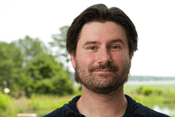 Bill Whorton is a web developer focused on creating rich, responsive web experiences. He has a diverse background of technical and non-technical experience in nearly every aspect of software development. Bill handles front and back-end web development for the Chesapeake Bay Program (CBP) suite of websites. In his spare time he writes short fiction, brews beer, and plays too many video games. He lives in Eastport with his wife, Amy, his dogs Carmen and Jack, and his cats Indy and Hambone.
Bill Whorton is a web developer focused on creating rich, responsive web experiences. He has a diverse background of technical and non-technical experience in nearly every aspect of software development. Bill handles front and back-end web development for the Chesapeake Bay Program (CBP) suite of websites. In his spare time he writes short fiction, brews beer, and plays too many video games. He lives in Eastport with his wife, Amy, his dogs Carmen and Jack, and his cats Indy and Hambone.
IAN welcomes Jamieson Colburn
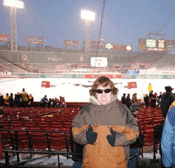 Jamieson has joined IAN supporting the CBP as their Cloud Architect. Prior to his role at CBP, Jamieson had been working as a contracted Systems Engineer for ARINC/Rockwell Collins developing internal tools for their network team, and consulting on latency sensitive applications, network management, and security compliance. At CBP, Jamieson is tasked with the migration and redesign of existing network infrastructure to leverage cloud technologies, with the end goal of providing CBP with an elastic computing environment that is capable of scaling to their future needs. In his free time, Jamieson enjoys working on open-source software and electronics projects.
Jamieson has joined IAN supporting the CBP as their Cloud Architect. Prior to his role at CBP, Jamieson had been working as a contracted Systems Engineer for ARINC/Rockwell Collins developing internal tools for their network team, and consulting on latency sensitive applications, network management, and security compliance. At CBP, Jamieson is tasked with the migration and redesign of existing network infrastructure to leverage cloud technologies, with the end goal of providing CBP with an elastic computing environment that is capable of scaling to their future needs. In his free time, Jamieson enjoys working on open-source software and electronics projects.
IAN in 2015
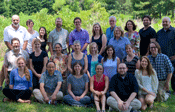 The Integration and Application Network has an exciting 2015 ahead. IAN has undergone a staffing expansion, with five new staff based at the Chesapeake Bay Program, a new administrative staff position, and two PhD students beginning in January 2015. A concerted teaching effort by IAN is being launched in 2015, with full semester courses in Science for Environmental Management (Spring 2015) and Communicating Science Effectively (Autumn) being offered. In addition to our ongoing Chesapeake Bay and Maryland Coastal Bays projects, we are looking forward to exciting projects in New York (Long Island Sound report card and New York Harbor School - Billion Oyster Project), India (with the National Centre for Sustainable Coastal Management) and Australia (Charles Darwin University and Great Barrier Reef Foundation). We have a great set of partners that we will be working with this year on a diverse suite of projects.
The Integration and Application Network has an exciting 2015 ahead. IAN has undergone a staffing expansion, with five new staff based at the Chesapeake Bay Program, a new administrative staff position, and two PhD students beginning in January 2015. A concerted teaching effort by IAN is being launched in 2015, with full semester courses in Science for Environmental Management (Spring 2015) and Communicating Science Effectively (Autumn) being offered. In addition to our ongoing Chesapeake Bay and Maryland Coastal Bays projects, we are looking forward to exciting projects in New York (Long Island Sound report card and New York Harbor School - Billion Oyster Project), India (with the National Centre for Sustainable Coastal Management) and Australia (Charles Darwin University and Great Barrier Reef Foundation). We have a great set of partners that we will be working with this year on a diverse suite of projects.
Blog and Video Highlights
Video
- Anne Bowser's "An Overview of Citizen Science and Crowdsourcing in Federal Agencies" is now available on our seminar series page and YouTube
Blog
- Webstock 2015: One day of peace & the internet
- Reginald V. Truitt in his own words: A visit to the Maryland Room archives
- In memory of Jay Zieman, University of Virginia seagrass ecologist
- Willamette River Report Card - I can see the light at the end of the tunnel
Chesapeake Bay health improved in 2014
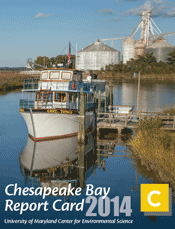 Strong improvements were seen in 2014 Bay health as almost all indicator scores improved. Overall, Chesapeake Bay scored 50%, up from the previous year's score of 45% (both C's). While the improvements are promising, most regions still have poor to moderate scores. The highest scoring indicator was dissolved oxygen (89%, an A), and the lowest scoring indicator was water clarity (15%, an F). Aquatic grass scores improved or stayed the same in all regions, due to the expansion of Ruppia. Both nitrogen and phosphorus are showing significantly improving trends over time, while chlorophyll a and water clarity have declining trends. This report card includes an analysis on the resiliency of coastal wetlands to current and future sea level rise rates as part of a Climate Change Resilience Index study. For further details, visit the Report Card website.
Strong improvements were seen in 2014 Bay health as almost all indicator scores improved. Overall, Chesapeake Bay scored 50%, up from the previous year's score of 45% (both C's). While the improvements are promising, most regions still have poor to moderate scores. The highest scoring indicator was dissolved oxygen (89%, an A), and the lowest scoring indicator was water clarity (15%, an F). Aquatic grass scores improved or stayed the same in all regions, due to the expansion of Ruppia. Both nitrogen and phosphorus are showing significantly improving trends over time, while chlorophyll a and water clarity have declining trends. This report card includes an analysis on the resiliency of coastal wetlands to current and future sea level rise rates as part of a Climate Change Resilience Index study. For further details, visit the Report Card website.
Chesapeake Bay Program's Creative Team hosts WebStock 2016
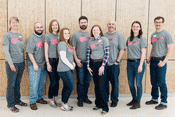 This month, the Chesapeake Bay Program Creative Team hosted a one-day symposium on all things web for an audience of friends and colleagues. Known as WebStock, the annual event was revitalized last spring as a way for the Creative Team to introduce others to the work they do and the methods they use to do it. Indeed, participants gained an understanding of how the Creative Team can help them and how they can use the team's own tools and processes to improve their work. As we closed the event by sharing what we learned, two themes rose to the top: the amount of thought that goes into creating great work and the importance of working with a cross-functional team.
This month, the Chesapeake Bay Program Creative Team hosted a one-day symposium on all things web for an audience of friends and colleagues. Known as WebStock, the annual event was revitalized last spring as a way for the Creative Team to introduce others to the work they do and the methods they use to do it. Indeed, participants gained an understanding of how the Creative Team can help them and how they can use the team's own tools and processes to improve their work. As we closed the event by sharing what we learned, two themes rose to the top: the amount of thought that goes into creating great work and the importance of working with a cross-functional team.
IAN welcomes Andrew Sommerlot
 Andrew is the newest member of the modeling team working with the University of Maryland Center for Environmental Science at the Chesapeake Bay Program (CBP). Andrew received undergraduate and masters degree from Michigan State University in Biosystems Engineering, and is finishing his PhD in the same discipline at Virginia Tech. Andrew studied watershed-scale pollutant transport and BMP auctions during his masters degree program and real-time hydrologic forecasts at Virginia Tech. Andrew's expertise is in hydrologic processes, physical modeling, machine learning, and decision support systems. Before arriving at CBP, he worked as a graduate researcher at Michigan State and Virginia Tech, and in electronics manufacturing with remote sensing technology.
Andrew is the newest member of the modeling team working with the University of Maryland Center for Environmental Science at the Chesapeake Bay Program (CBP). Andrew received undergraduate and masters degree from Michigan State University in Biosystems Engineering, and is finishing his PhD in the same discipline at Virginia Tech. Andrew studied watershed-scale pollutant transport and BMP auctions during his masters degree program and real-time hydrologic forecasts at Virginia Tech. Andrew's expertise is in hydrologic processes, physical modeling, machine learning, and decision support systems. Before arriving at CBP, he worked as a graduate researcher at Michigan State and Virginia Tech, and in electronics manufacturing with remote sensing technology.
IAN welcomes Qian Zhang
 Qian Zhang has joined UMCES as a monitoring data analyst at the Chesapeake Bay Program (CBP). Within the CBP's Scientific, Technical Assessment and Reporting team, his main role is to develop statistical methods of data analysis that use the extensive data available through the CBP partnership to better understand factors that drive water quality patterns. Qian obtained his Ph.D. in Environmental Engineering from Johns Hopkins University (JHU), in addition to two master degrees from JHU (one in environmental engineering and the other in statistics). He is both thrilled and thankful to have this opportunity to stay in the Chesapeake community and to continue contributing his skills toward Chesapeake Bay management and protection. Qian lives in Baltimore with his wife Claire and son Lucas. In his free time, he enjoys family road trips and playing soccer.
Qian Zhang has joined UMCES as a monitoring data analyst at the Chesapeake Bay Program (CBP). Within the CBP's Scientific, Technical Assessment and Reporting team, his main role is to develop statistical methods of data analysis that use the extensive data available through the CBP partnership to better understand factors that drive water quality patterns. Qian obtained his Ph.D. in Environmental Engineering from Johns Hopkins University (JHU), in addition to two master degrees from JHU (one in environmental engineering and the other in statistics). He is both thrilled and thankful to have this opportunity to stay in the Chesapeake community and to continue contributing his skills toward Chesapeake Bay management and protection. Qian lives in Baltimore with his wife Claire and son Lucas. In his free time, he enjoys family road trips and playing soccer.

